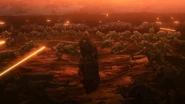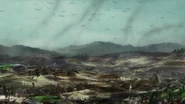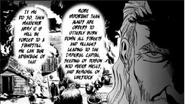| ||||||||||||||||||||||||||||||||||
Second Battle of Alnus Hill was the second battle the Japan Self-Defense Forces fought in the Special Region, after the First Battle of Alnus Hill which ended in a decisive defeat for the Empire and a dramatic weakening of Imperial military might and political standing due to severe casualties.
The Second Battle of Alnus Hill is considered to be a mass slaughter for the Allied Force rather than a battle.
Prelude
After its victory at the Battle of Ginza, the Japan Self-Defense Forces sent its forces into the Special Region, where Imperial soldiers were waiting. During the First Battle of Alnus Hill, the Empire lost all the reinforcement troops that were sent to reinforce the remaining of the retreating troops from Ginza. With the Imperial Military now reduced by 60% and a growing pro-peace faction in the Imperial Senate, Emperor Molt Sol Augustus gathered an second army of 100,000 soldiers provided by his vassal states, including Elbe, Mudwan, Alguna, and Ligu. These forces were ostensibly sent to repel the invaders and send them back across the Gate. In truth, Augustus knew the JSDF was far more powerful than his allied armies, and in fact, sent his rivals with the intention that they would be killed in battle, thus minimizing the chances of rebellion.
At first, all leaders of the Allied Army were confident that they could win the battle easily since the JSDF only had 10 000 men at least while they had 300 000 in total plus the fact that all of them were completely clueless about the vast and technological superior weaponry of the JSDF. Only Duran was wise enough to take some caution about the battle due to the fact the whole 60000 soldiers of the Imperial Army were killed in short time after attacking Japan in Ginza. His suspicions about the Empire were further confirmed when he learned that the Imperial Army soldiers were absent before the first assault.
When all the Allied force started attacking, much to their horrors, the JSDF didn't uses spears, swords and arrow as well as melee to attack them like they expected in normal warfare in Special Region. Instead of they used tanks, mortar and artillery to decimate the whole massive army into dust and mountain of corpses in short amount of times.
Allied Kingdoms' 1st Offensive
The first attack on the JSDF positions were spearheaded by the armies of the Alguna, Mudwan, and League. The body of the Allied Army, including infantry, cavalry, and goblin auxiliaries marched into a "fire zone" set up by the JSDF, ignoring the warning signs (written in the Imperial language) placed by the JSDF. The Allied forces were fired upon by JSDF artillery and were quickly devastated. In the first attack, 10,000 soldiers were killed and the rest were forced to retreat. The Kings of Alguna and Mudwan, as well as the Duke of Ligu, were killed by artillery shells..
Allied Kingdoms' 2nd Offensive
During the second attack the Allied Army tried to taking advantage of their numerical superiority over the JSDF and overwhelm the enemy forces with the sheer force of numbers, which also included Dragon riders. The new tactic proved to be equally unsuccessful and the Allied Army's forces were easily repulsed by the far superior and modern weaponry of the JSDF, which included light machine guns, artillery strikes, entrenched Type 74 tanks, and Type 87 mobile anti-aircraft guns. In this attack, 40,000 Special Region soldiers were killed.
Allied Kingdoms' 3rd Offensive
After retreating a second time, Duran devised a night attack, intending to catch the JSDF by surprise. While his forces managed to advance closer to the JSDF positions, they were detected through the use of night vision equipment and Illumination shells. The JSDF forces fired artillery and small arms at the soldiers of the Allied Army, which their primitive shields and armors proved useless against. As his men fell around him, Duran managed to fire a single arrow at the JSDF positions, though it is unclear if it hit anyone, but most likely not as Duran mentioned he never made it further than halfway uphill, shortly before being severely wounded by artillery fire, losing his left arm and leg. In the third assault, 20,000 troops of the Special Region were killed.
Aftermath
After the battle, the bodies of the troops of the Allied kingdoms were presumably buried in a mass grave by the JSDF using heavy excavating machinery. At the same time, the JSDF began construction of a more permanent base at Alnus, including in it defensive walls and machine gun nests, barracks, command posts, armories, supply warehouses, motor pools, and even an air base. When Emperor Augustus heard the news of the defeat, he ordered a scorched earth campaign in an attempt to slow the JSDF advance. This was the official reason for the order. In actuality, it was to further weaken the vassal states and make them unable to rebel against the Empire. However, the tactic did little to none to the advance of the modern, mechanized, and highly mobile JSDF forces since Molt had no ideas about the knowledge of modern vehicles like the Humvee or aircraft since he assumed that JSDF used horses. Additionally, due to Molt's lack of understanding of modern warfare and tactics, he never realize that the conventional resources of Special Region meant extremely little to none for the JSDF since modern warfare emphasizes on swift attack and retreat to main base for refuel so the JSDF not even bother to take food, water source, primitive tools or even moneys from villages to fuel their advance. Consequently, his shallow strategy also causes a large portion Imperial citizens to outright despise him and the Empire in which they began to side and support the JSDF plus the fact that he damages the tax income and food sources of the Empire for no good reasons. Finally, he also proposed to build strongholds at various locations to force the JSDF to bleed and crumble under the pressure, however, he cannot realize that all kinds of strongholds the Empire can build will be turned into dust by JSDF tank shell, artillery barrage, and air bombardment.
After the defeat, the Empire lost significant amounts of military and political power, and was no longer able to control the area surrounding the Gate, including the village of Coda and the city of Italica. Both of these cities quickly fell under the JSDF sphere of influence in the Special Region. Many survivors of the vassal states deserted and became bandits, who later attempted to seize control of Italica, but were promptly defeated with JSDF aerial support during the Battle of Italica. Furthermore, due to all the soldiers of the Allied Army having their own money with them, and the JSDF not collecting them, the Empire suffered a wealth crisis shortly afterwards.
As King Duran managed to figure out Molt's scheme, he and the rest of the ruling families of the vassal states wanted some payback from the Emperor for tricking them into the butchery. Their chance of revenge finally came after Itami killed the Flame Dragon. After the Battle of Mount Tube, Itami was given multiple awards and aristocratic titles. Duran also gave the JSDF access to numerous mining locations.


























